I am a strong proponent of providing individuals with a means to move themselves in space. Since the 1980s, I've worked with children and adults, their significant others, primary therapists, and physicians in an effort to procure manual and powered mobility devices. I've also had the pleasure of working with rehab engineers who made it possible for children to trial power mobility using bases such as the one designed by Mark Bressler and the Cooper Car in the 1980s. It is exciting to see the next generation of therapists and designers creating opportunities for children in a variety of creative ways.
When a typically developing child starts moving their body, several aspects of development are taking place, including motor control (both gross and fine), vision skills, motor planning, sensory processing, socialization, cause & effect, communication, initiation of task, form & place, intellectual skills, and participation. Children who do not have the opportunity to move themselves risk having insufficient development in these areas. Charlene Butler demonstrated that children between 20 and 36 months of age could learn to use powered wheelchairs and reported positive changes in social, emotional, and intellectual behavior (Butler et al., 1984). For the past 40 years, evidence has documented the benefits of providing children with opportunities for self-initiated movement, which include many of the skills mentioned above (Breed, 1982; Evans, 2017; Anderson et al., 2013; Plummer et al., 2020; Livingstone, 2010; Rosen et al., 2018; Nilsson et al., 1998).
The concept that mobility is a human right has been a mantra since the infancy of the profession of wheelchairs and seating. C. Kerry Jones formalized this in his plenary speech at the Canadian Seating and Mobility Conference in 1993, titled "The Ten Commandments of Seating" (Jones, 1993). I was thrilled when the United Nations published this position in their Conventions on People with Disabilities in 2006 (United Nations, 2006).
Early intervention is the term used when providing therapy for children aged 0-3. For many years, the intervention of alternative mobility devices for young children was called "early mobility," paralleling the term for the practice of "early intervention." In 2020, the phrase "on-time mobility" was coined during the 2020 International Seating Symposium in Vancouver with the intention of stating that the intervention could be provided at the age when typically developing children begin to initiate movement. The reality is that self-initiated movement could be augmented using equipment in an attempt to parallel typical development or when the child was ready. Rather than being early mobility, it was "on time." The ON TIME framework was developed by Sabet, Feldner, Tucker, Logan, and Galloway (2022). Sabet and her colleagues proposed that "all children have the right to be mobile throughout their development to explore, engage in relationships, and develop agency to cocreate their lives" (Sabet et al., 2022). The goal is to consider a paradigm shift in the clinical practice of those providing intervention for children aged 0-3. This encourages the incorporation of assistive devices as part of the therapeutic intervention for any type of self-initiated movement, including crawling, walking, or a mobility toy/device.
The ON TIME framework's five principles
- Timing: ON TIME mobility proposes the change in terms from early mobility to focus on providing intervention that parallels typical development for self-initiated movement.
- Urgency: Evidence demonstrates the importance of self-initiated movement during the first year of life. It is urgent to recognize the need to provide mobility opportunities for children who are physically unable to move themselves in space in order to prevent delays that can occur by allowing dependency for movement.
- Multimodal: A multimodal approach to mobility combines gross motor skill training with alternative mobility options, including options for crawling, walking, and manual & power wheelchair use. This parallels the observation that typically developing children choose varying self-initiated movement options prior to ambulation.
- Examples of these opportunities would include low-to-floor manual devices like the Leckey Firefly Scoot or Bella's Bumbas, adapted ride-on toys, powered ride-on devices, manual wheelchairs, power wheelchairs, gait trainers, and other devices that assist in self-initiated movement in space.
- Frequency in real world environments: Research of typical development provides data documenting thousands of steps a toddler takes in a day while learning to walk. Dosage for the provision of self-initiated movement including frequency and duration is critical.
- Sociability: Evidence, beginning with Butler's research in the 1980s, illustrates the increased benefit of socialization when a child is able to self-initiate movement. Providing alternative options for a child to move in space will enhance this development. (Sabet et al., 2022)
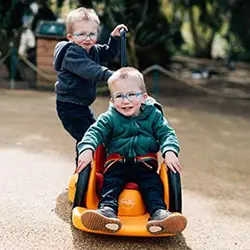 Firefly Scooot
Firefly Scooot
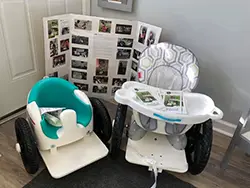 Bella's Bumbas
Bella's Bumbas
 Modified ride-on car from GoBabyGo Program, fabricated by STEM students at New Trier High School in Illinois
Modified ride-on car from GoBabyGo Program, fabricated by STEM students at New Trier High School in Illinois
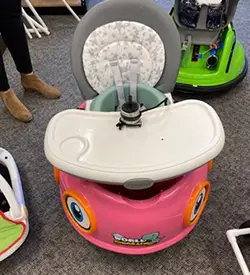 Adapted bumper car
Adapted bumper car
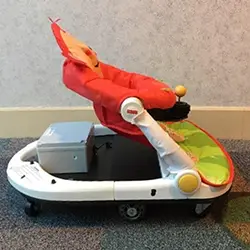 Baby Bug, Shriner Hospital Salt Lake City, Utah
Baby Bug, Shriner Hospital Salt Lake City, Utah
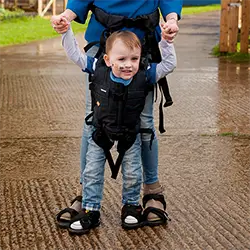 Firefly Upsee
Firefly Upsee
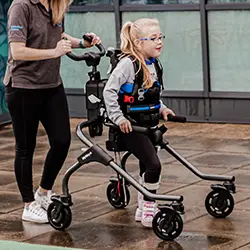 Leckey MyWay+
Leckey MyWay+
Providing a child with alternative mobility options provides a child with the sensory, cause & effect, motor planning, visual, social, and other experiences that assist with development. A manual or power device that looks like a toy and is lower to the ground can prepare a child for a manual or power wheelchair gaining acceptance from the family, medical professionals, and school staff. The ZIPPIE Q300 M Mini has the smallest turning radius, allowing a child to explore the environment with greater maneuverability in small or crowded spaces. A very young child can use it when provided with proper positioning, appropriate access methods, and adequate training. It can be used as a tool for learning in preparation for purchase before the child attends school.
Summary
The ON TIME Mobility framework is a critical addition to the profession of wheelchairs and seating, providing principles for intervention. Sabet et al., are leaders in this area and substantiate the mantra that mobility is a human right. Assistive devices may enhance a child's ability to move and provide opportunity for learning and development. There is a plethora of commercially available equipment. Programs such as gobabygo and other initiatives may provide resources for DIY methods to adapt toys or create systems for children.
References
- Anderson, D. J., Campos, J. J., Witherington, D. C. (2013). The role of locomotion in psychological development. Front Psychology. 4 440
- Butler, C., Okamoto, G. A., McKay, T. M. (1983). Powered mobility for very young disabled children. Developmental Medicine and Child Neurology Volume 25, Issue 4 p 472-474.
- Breed, A. L., Ibler, I. (1982). The motorized wheelchair: New freedom, new responsibility and new problems. Developmental Medicine and Child Neurology. 24, 366-372.
- Evans, N., Baines, R. (2017). Trends, goals, and outcomes for children and families using early powered mobility in a charitable loan scheme. Journal of Enabling Technologies, 10.1108/JET-08-2017-0032.11.4 (138-147).
- Field, D., & Livingstone, R. (2018). Power mobility skill progression for children and adolescents: a systematic re-view of measures and their clinical application. Developmental Medicine and Child Neurology, 60, 997-1011. https://doi.org/10.1111/dmcn.13709
- Jones, C. K. (1993). The Ten Commandments of Seating. Canadian Seating and Mobility Conference Plenary Presentation.
- Livingstone, R. (2010). A critical review of powered mobility assessment and training for children. Disability and Rehabilitation: Assistive Technology, 5, 392-400. https://doi.org/10.3109/17483107.2010.496097
- Nilsson, L., & Nyberg, P. (1998). Training in powered wheelchair, benefits for individuals at an early development level. Poster presentation at The 12th Congress of the World Federation of Occupational Therapists, Montreal, Canada. https://doi.org/10.13140/RG.2.1.1016.5608
- Plummer, T., Logan S. W., Morress, C. (2020). Explorer Mini: Infant's initial experience with a novel pediatric powered mobility device. Physical & Occupational Therapy in Pediatrics. 10.1080/01942638.2020.1819935, 41, 2, (192-208).
- Rosen, L., Plummer, T., Sabet, A., Lange, M. L., Livingstone, R. (2018). RESNA position on the application of power mobility devices for pediatric users. Assistive Technology, 10.1080/10400435.2017.1415575, 35, 1, (14-
- Sabet, A., Feldner, H., Tucker, J. Logan, S., Galloway, J. C., (2022). ON TIME mobility: Advocating for Mobility Equity. 22Pediatric Physical Therapy 34 546-560.
- United Nations. (2006). United Nations Convention on Rights of Persons with Disabilities 2006 available online https://social.desa.un.org/ (accessed on June 16, 2023).
With over 40 years of clinical practice as an OT, Jessica Presperin Pedersen has worked in all sectors of the wheelchair and seating industry as a master clinician, supplier, manufacturing consultant, design representative, and educator. Dr. Presperin Pedersen was a pioneer in the development of the profession of wheelchairs and seating in the 1980s and has spent the last two decades contributing to the research world to demonstrate evidence for knowledge translation in the clinic, advocacy, and product development. She is a RESNA and AOTA Fellow, serves on the Clinician Task Force, the Seating and Wheeled Mobility Committee for AOTA, and has shared her experiences internationally through publications and presentations.